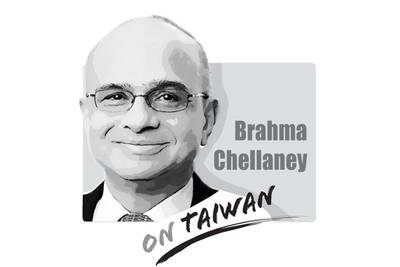The Chinese Communist Party (CCP) concluded its 16th National Congress yesterday, with Vice President Hu Jintao (
TV footage of the congress shows delegates casting their votes in order. The voting results also came out as planned, an indication that the party maintains absolute control. The scene was reminiscent of the KMT's 5th National Congress in 1976, during which then president Chiang Ching-kuo (
The KMT and the CCP are fraternal twins born of the Soviet Communist Party's model -- but they followed very different paths of development. After retreating to Taiwan in 1949, the KMT followed an authoritarian capitalist road, liberalizing the economy while maintaining a tight grip on politics.
Later Taiwan's middle class became the mainstay of society and a driving force behind social and political liberalization. After the lifting of martial law and the ban on political parties and newspapers, the democratization process in Taiwan became irreversible. It led to the peaceful transition of political power in 2000 that saw the KMT become an opposition party.
Will the CCP follow in the KMT's footsteps? At this week's congress in Beijing, Jiang's "Three Repre-sents" dictum was incorporated into the party charter. The dictum labels businesspeople an "advanced force" on a par with labor and farmers. This has already sowed the seeds for qualitative change in the party.
The CCP can no longer claim to represent Maoist proletariat rule after a capitalist market mechanism was incorporated into "socialism with Chinese characteristics." Given the tremendous economic developments in Jiang's era, China no longer looks like a communist state. It uses its cheap labor, abundant resources and a huge market to attract investment and grab overseas markets. China is now more capitalist than many capitalist countries.
The CCP now looks like the KMT of 30 years ago -- a party facing the conflict between an open economy and an authoritarian political system. Economic development has created a formidable middle class and the party can no longer ignore this new force in society. The party must incorporate it. The people who attracted the most attention at this week's congress were not bureaucrats, but the new capitalist nobility.
The CCP's 16th National Congress marks the beginning of qualitative change in the party. The new generation of leaders must solicit help from business tycoons and the middle class to deal with the growing gaps between rich and poor and between regions as well as a rising unemployment rate. This in turn means party leaders must give more power to business leaders and the middle class to ensure their cooperation. This will be the beginning of quantitative change in the party.
The middle class was an important driving force behind the KMT's transition. Will it play a similar role in China? The just-concluded congress has planted the seeds for such change. Hopefully these seeds will grow into trees.

Donald Trump’s return to the White House has offered Taiwan a paradoxical mix of reassurance and risk. Trump’s visceral hostility toward China could reinforce deterrence in the Taiwan Strait. Yet his disdain for alliances and penchant for transactional bargaining threaten to erode what Taiwan needs most: a reliable US commitment. Taiwan’s security depends less on US power than on US reliability, but Trump is undermining the latter. Deterrence without credibility is a hollow shield. Trump’s China policy in his second term has oscillated wildly between confrontation and conciliation. One day, he threatens Beijing with “massive” tariffs and calls China America’s “greatest geopolitical
US President Donald Trump’s seemingly throwaway “Taiwan is Taiwan” statement has been appearing in headlines all over the media. Although it appears to have been made in passing, the comment nevertheless reveals something about Trump’s views and his understanding of Taiwan’s situation. In line with the Taiwan Relations Act, the US and Taiwan enjoy unofficial, but close economic, cultural and national defense ties. They lack official diplomatic relations, but maintain a partnership based on shared democratic values and strategic alignment. Excluding China, Taiwan maintains a level of diplomatic relations, official or otherwise, with many nations worldwide. It can be said that
Chinese Nationalist Party (KMT) Chairwoman Cheng Li-wun (鄭麗文) made the astonishing assertion during an interview with Germany’s Deutsche Welle, published on Friday last week, that Russian President Vladimir Putin is not a dictator. She also essentially absolved Putin of blame for initiating the war in Ukraine. Commentators have since listed the reasons that Cheng’s assertion was not only absurd, but bordered on dangerous. Her claim is certainly absurd to the extent that there is no need to discuss the substance of it: It would be far more useful to assess what drove her to make the point and stick so
The central bank has launched a redesign of the New Taiwan dollar banknotes, prompting questions from Chinese Nationalist Party (KMT) legislators — “Are we not promoting digital payments? Why spend NT$5 billion on a redesign?” Many assume that cash will disappear in the digital age, but they forget that it represents the ultimate trust in the system. Banknotes do not become obsolete, they do not crash, they cannot be frozen and they leave no record of transactions. They remain the cleanest means of exchange in a free society. In a fully digitized world, every purchase, donation and action leaves behind data.